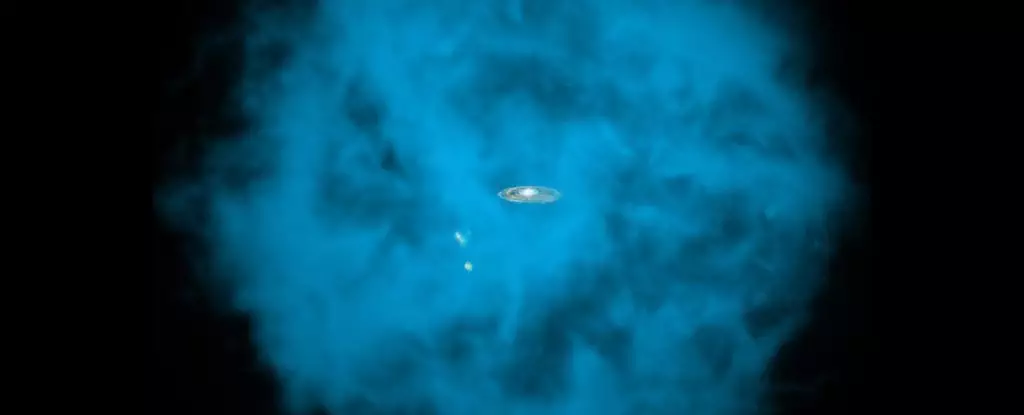In a profound leap for astronomy, recent findings illuminate the long-standing enigma of the Universe’s missing baryonic matter. For decades, scientists have grappled with the unsettling realization that nearly half of the Universe’s visible matter seemed to vanish into the ether—until now. A collaborative effort by a diverse group of astronomers and astrophysicists has unveiled the hiding place of this elusive matter: vast, mostly invisible clouds of ionized hydrogen that exist in the void surrounding galaxies. This discovery not only underscores the ingenuity of modern astrophysical methods but also reshapes our understanding of cosmic structure.
The Search for the Elusive Hydrogen
Boryana Hadzhiyska, an astronomer from the University of California, Berkeley, emphasizes the significance of this finding. The research team posits that the intergalactic regions around galaxies may account for the majority of what was once thought to be the missing hydrogen. To put this into perspective, regular baryonic matter constitutes merely 5% of the Universe’s overall matter-energy content, while dark matter and dark energy dominate the remaining composition at 27% and 68%, respectively. The crux of the mystery lies in hydrogen, which, comprising approximately 90% of the Universe by atom count and 73% by mass, remains a central focus of inquiries into cosmic evolution.
Despite its prevalence, detecting hydrogen in the early Universe is quite the challenge because ionized hydrogen emits only a faint, elusive glow—particularly given the vast distances and low densities involved. Historical observations had been insufficient in showcasing this hydrogen, leading to an underestimation of its abundance. Nevertheless, researchers have harnessed innovative techniques that capitalize on the cosmic microwave background radiation, the remnant light from the Universe’s inception, as a cosmic backlight. This approach emphasizes how cutting-edge technology can reveal cosmic secrets that once appeared impenetrable.
Using Light to Hunt for Matter
The team employed a phenomenon known as the kinematic Sunyaev-Zel’dovich effect, which allows scientists to observe how the cosmic microwave background light scatters off electrons within the gas. To magnify these faint signals, they meticulously stacked observations from over a million distant glowing red galaxies located within an expansive radius of 8 billion light-years from the Milky Way. This technique successfully illuminated the previously hidden vast halos of hydrogen enveloping these galaxies, suggesting a scale far greater than previously theorized.
The implications of their findings extend well beyond merely confirming the presence of missing matter. The sheer size of these halos raises intriguing questions about their formation and behavior. Is it conceivable that these expansive envelopes of hydrogen are more substantial than what the current survey can account for? Ferraro, another prominent researcher involved in the study, notes, “The measurements are certainly consistent with finding all of the gas,” suggesting further revelations await as research progresses.
Black Holes and Cosmic Winds: Complex Interactions
Discovering these immense halos opens up additional layers of complexity concerning the dynamics of galaxy evolution. Central to many galaxies are supermassive black holes, which play a pivotal role in modulating the activity within their host galaxies. As these black holes undergo active phases, they unleash extraordinary jets of material that collide with intergalactic gas, effectively pushing it outward and influencing the star formation rates.
The newfound evidence of larger hydrogen halos suggests the possibility of episodic black hole activity, possibly sparking additional cycles within the broader lifecycle of galaxies. This cyclical nature aligns seamlessly with observations of dormant black holes unexpectedly reigniting. The revelations surrounding black holes, therefore, not only inform our understanding of these enigmatic entities but illuminate their integral role in shaping the composition and evolution of galaxies writ large.
Connecting Cosmic Threads: The Role of Dark Matter
As astronomers continue to unravel this celestial puzzle, it’s imperative to recognize that the missing baryonic matter forms a web intricately linked to dark matter filaments, the very scaffolding of the cosmos. The ongoing research aims to reinforce the connection between gas distributions and dark matter structures, enriching future analyses of cosmic evolution. Such inquiries promise to yield valuable insights into both the formation of galaxies and the overall structure of the Universe.
This groundbreaking research marks a significant milestone in our quest to uncover the Universe’s hidden treasures. As scientists piece together the fragments of this cosmic mystery, one thing is certain: the realms of space and the interactions within it are far more intricate than previously imagined. Each new revelation not only broadens our cosmic perspective but also stimulates an insatiable curiosity to delve deeper into the abyss, in search of knowledge that has eluded humanity for generations.


Leave a Reply